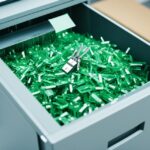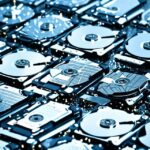Advancements in Secure Data Recycling Technologies
In 2024, the landscape of data security and tech recycling is rapidly evolving. Companies are increasingly seeking efficient ways to manage data and recycle technology for cost savings and environmental responsibility. This article will explore the key developments and innovations in secure data recycling technologies in the digital age.
With the rise of secure data recycling, businesses are prioritizing data security measures and adhering to strict data privacy regulations. One essential aspect of secure data recycling is secure data erasure, which ensures that sensitive information is permanently removed from devices, making it unrecoverable. This process plays a crucial role in protecting businesses from data leaks and ensuring compliance with data access governance.
Data governance frameworks and professional data governance solutions have emerged as vital tools for organizations aiming to achieve effective data recycling and secure data erasure. These frameworks provide real-time auditing, allowing businesses to track and monitor data throughout the recycling process.
As advancements continue, AI and machine learning are revolutionizing secure data recycling. AI technologies enable precision sorting, enhancing the efficiency and accuracy of recycling processes, while machine learning algorithms improve sustainable recycling practices. These technologies hold significant potential in transforming the recycling industry by optimizing sorting processes.
Moreover, the field of e-waste recycling has seen remarkable innovations. IoT sensors and blockchain technology ensure transparent e-waste recycling, enhancing accountability and responsible e-waste management. Recycling lithium-ion batteries and rare earth metals are also areas of focus, contributing to the sustainable disposal of electronic waste.
In conclusion, the advancements in secure data recycling technologies and e-waste recycling present exciting opportunities for a sustainable future. By embracing these innovations, businesses can prioritize secure data erasure, data privacy regulations, and responsible waste management, leading to a cleaner and more environmentally friendly world.
The Importance of Secure Data Erasure
Secure data erasure plays a crucial role in data recycling and protection. It ensures that data is permanently and securely removed from devices, making it unrecoverable. Data erasure is especially important in today’s digital landscape, where data leaks and unauthorized access can result in significant financial and reputational damage.
DIY Data Governance
Implementing DIY data governance strategies is a cost-effective approach for businesses to manage their data securely. By utilizing professional-grade tools and techniques, organizations can take control of their data and ensure compliance with data privacy regulations. DIY data governance empowers companies to monitor data access, implement real-time auditing, and identify potential vulnerabilities.
Real-time auditing allows organizations to track data movement within their systems, ensuring that only authorized individuals have access to sensitive information. This proactive approach minimizes the risk of data leaks and unauthorized data access.
Secure Data Erasure Techniques
Secure data erasure techniques involve the use of advanced algorithms and software to overwrite data on storage devices. This process effectively removes traces of the original data, making it virtually impossible to recover. Professional-grade tools and techniques ensure that each storage device undergoes a rigorous data erasure process, leaving no room for data remnants.
One of the key benefits of secure data erasure is the ability to recover valuable resources from retired or obsolete devices. By securely erasing data, organizations can reuse or sell these devices with peace of mind, knowing that sensitive information has been completely wiped.
Data Access Governance
Data access governance is a vital aspect of secure data erasure. It involves implementing policies and controls to manage and control user access to data. By enforcing strict access controls, organizations can prevent unauthorized individuals from retrieving sensitive information, reducing the risk of data breaches.
“Secure data erasure is a fundamental component of a robust data governance framework. It ensures that organizations can safely dispose of retired devices while protecting sensitive information from falling into the wrong hands.”
| Benefits of Secure Data Erasure | Challenges of Data Erasure |
|---|---|
|
|
Implementing secure data erasure as part of a comprehensive data management strategy is essential for businesses in maintaining data integrity, minimizing the risk of data leaks, and protecting sensitive information from unauthorized access. By adopting professional-grade tools and techniques, organizations can ensure the secure and responsible disposal of data-bearing devices, paving the way for a more sustainable and secure digital environment.
The Role of AI and Machine Learning in Secure Data Recycling
AI and machine learning technologies are revolutionizing the recycling industry, including secure data recycling. These advanced technologies offer unprecedented opportunities for precision sorting and sustainable recycling practices. In the recycling industry, data privacy and secure data erasure are of utmost importance, and AI and machine learning are playing a significant role in enhancing these processes.
With AI and machine learning algorithms, recycling centers can automate and optimize sorting processes, ensuring more accurate identification and separation of different materials. This precision sorting enables efficient recycling of various components, reducing waste and maximizing resource recovery.
Moreover, AI and machine learning algorithms can analyze vast amounts of data to identify patterns and predict trends. This data-driven approach helps recycling centers make informed decisions, improve operational efficiency, and implement sustainable recycling practices.
“AI and machine learning technologies have the potential to revolutionize the recycling industry by enabling more efficient sorting processes and ensuring sustainable recycling practices.” – Recycling Industry Expert
By applying AI and machine learning in secure data recycling, recycling centers can enhance data security measures and comply with data privacy regulations. These technologies enable real-time auditing of data erasure processes to minimize the risk of data leaks and ensure comprehensive data access governance.
The Benefits of AI and Machine Learning in Secure Data Recycling:
- Improved precision sorting and separation of recyclable materials
- Increased operational efficiency and cost savings
- Enhanced data security measures and compliance with regulations
- Real-time auditing for data erasure processes
- Optimized resource recovery and minimized waste
- Implementation of sustainable recycling practices
As AI and machine learning technologies continue to evolve, we can expect further advancements in the recycling industry. These technologies have the potential to transform how we recycle and manage data, creating a more sustainable future for all.
The Role of AI and Machine Learning in Secure Data Recycling – A Comparative Analysis:
| Traditional Sorting Processes | AI and Machine Learning Sorting Processes |
|---|---|
| Labor-intensive and time-consuming | Automated and efficient |
| Inconsistent sorting accuracy | Precision sorting capabilities |
| Higher risk of material contamination | Improved separation of different materials |
| Less resource recovery | Maximized resource recovery |
Innovations in E-Waste Recycling Technologies
As the world grapples with the growing problem of electronic waste, innovative technologies are emerging to address the challenges of recycling and responsible waste management. These advancements pave the way for a more sustainable and environmentally conscious future.
IoT Sensors Revolutionize Recycling Efficiency
The integration of IoT sensors in e-waste recycling processes has revolutionized the industry by providing real-time data and optimizing operational efficiency. These sensors can monitor and track the movement of electronic devices throughout the recycling chain, ensuring transparent and traceable recycling practices.
| Advantages of IoT Sensors in E-Waste Recycling | Examples of IoT Sensor Applications |
|---|---|
| – Enhanced transparency and accountability | – Tracking the recycling journey of electronic devices |
| – Optimal resource allocation and process optimization | – Monitoring recycling rates and volumes |
| – Improved safety and compliance | – Ensuring proper handling and disposal of hazardous materials |
Blockchain Technology Enables Trust and Accountability
Blockchain technology has emerged as a game-changer in the field of e-waste recycling by providing a decentralized and transparent platform for recording and verifying transactions. By using blockchain, responsible e-waste management can be ensured through the immutable and auditable records it provides.
Recycling Lithium-Ion Batteries
The increasing use of lithium-ion batteries in electronic devices has led to the need for efficient and safe recycling methods. Innovations in battery recycling technologies enable the recovery of valuable materials such as lithium, cobalt, and nickel, reducing the environmental impact of these batteries.
Recycling Rare Earth Metals from Electronics
Electronic devices often contain precious rare earth metals that are critical for various industries. Recycling these metals from e-waste helps conserve natural resources and reduces reliance on mining. State-of-the-art recycling technologies extract valuable rare earth metals, such as neodymium and dysprosium, from discarded electronic devices.
With these innovations in e-waste recycling technologies, the industry is better equipped to tackle the rising global e-waste crisis. By harnessing the power of IoT sensors, transparent e-waste recycling practices, blockchain technology, and responsible waste management, we can create a sustainable future while minimizing the environmental impact of electronic waste.
Conclusion
The advancements in secure data recycling technologies and e-waste recycling present exciting opportunities for a sustainable future. AI and machine learning technologies, along with robotics, are revolutionizing the way we approach recycling, making processes more efficient and environmentally friendly. The integration of IoT sensors and blockchain technology enhances transparency and accountability in e-waste recycling. Furthermore, specialized innovations targeted at recycling specific components of electronic waste contribute to more effective waste management.
By embracing these advancements, we can create a future where secure data recycling and responsible e-waste recycling are priorities, leading to a cleaner and more sustainable world.
FAQ
What is secure data recycling?
Secure data recycling is the process of safely and permanently removing data from devices, ensuring it cannot be recovered or accessed. It plays a crucial role in data protection and privacy.
How does secure data erasure work?
Secure data erasure uses professional-grade tools and techniques to permanently delete data from devices. It ensures that the data cannot be recovered, protecting against data leaks and unauthorized access.
Why is secure data erasure important?
Secure data erasure is important to prevent data breaches and ensure compliance with data privacy regulations. It helps businesses maintain data security measures and data governance frameworks.
What role do AI and machine learning play in secure data recycling?
AI and machine learning technologies are revolutionizing the recycling industry, enabling precision sorting and sustainable recycling practices. They improve the efficiency of sorting processes, making data recycling more effective.
What are the advancements in e-waste recycling technologies?
There are various innovative technologies shaping the field of e-waste recycling. These include IoT sensors for transparent e-waste recycling, blockchain technology for enhanced accountability, and specialized methods for recycling specific electronic components.















